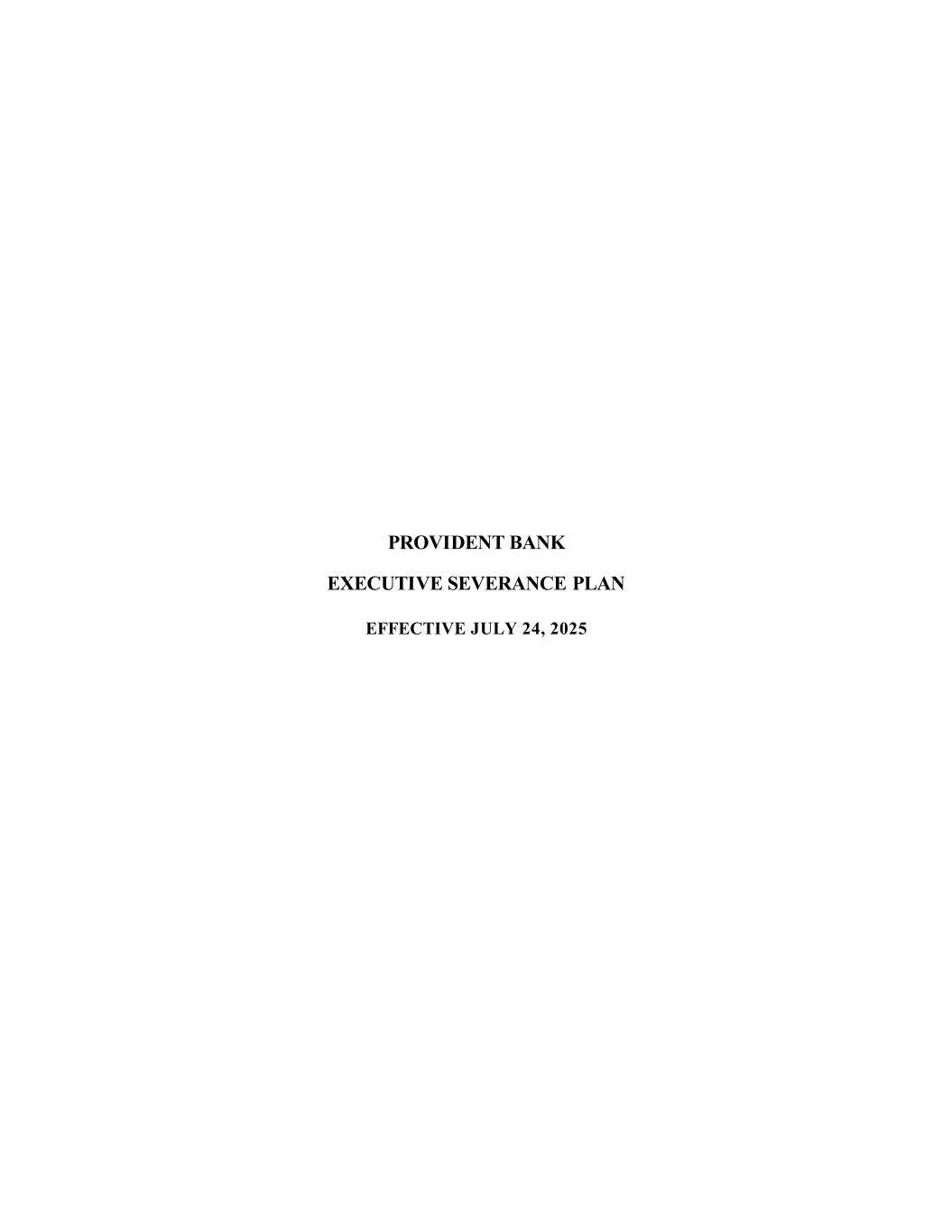
PROVIDENT BANK EXECUTIVE SEVERANCE PLAN EFFECTIVE JULY 24, 2025

TABLE OF CONTENTS INTRODUCTION ...........................................................................................................................1 ARTICLE I DEFINITIONS...........................................................................................................................1 ARTICLE II PARTICIPATION .....................................................................................................................2 ARTICLE III BENEFITS .................................................................................................................................3 ARTICLE IV CLAIMS PROCEDURE............................................................................................................7 ARTICLE V ADMINISTRATION .................................................................................................................9 ARTICLE VI AMENDMENT AND TERMINATION .................................................................................10 ARTICLE VII MISCELLANEOUS ................................................................................................................11 ARTICLE VIII REQUIRED INFORMATION ................................................................................................15 ARTICLE IX STATEMENT OF ERISA RIGHTS........................................................................................15 GENERAL PLAN INFORMATION ............................................................................................17 Exhibits have been removed and sent separately if applicable to the individual.
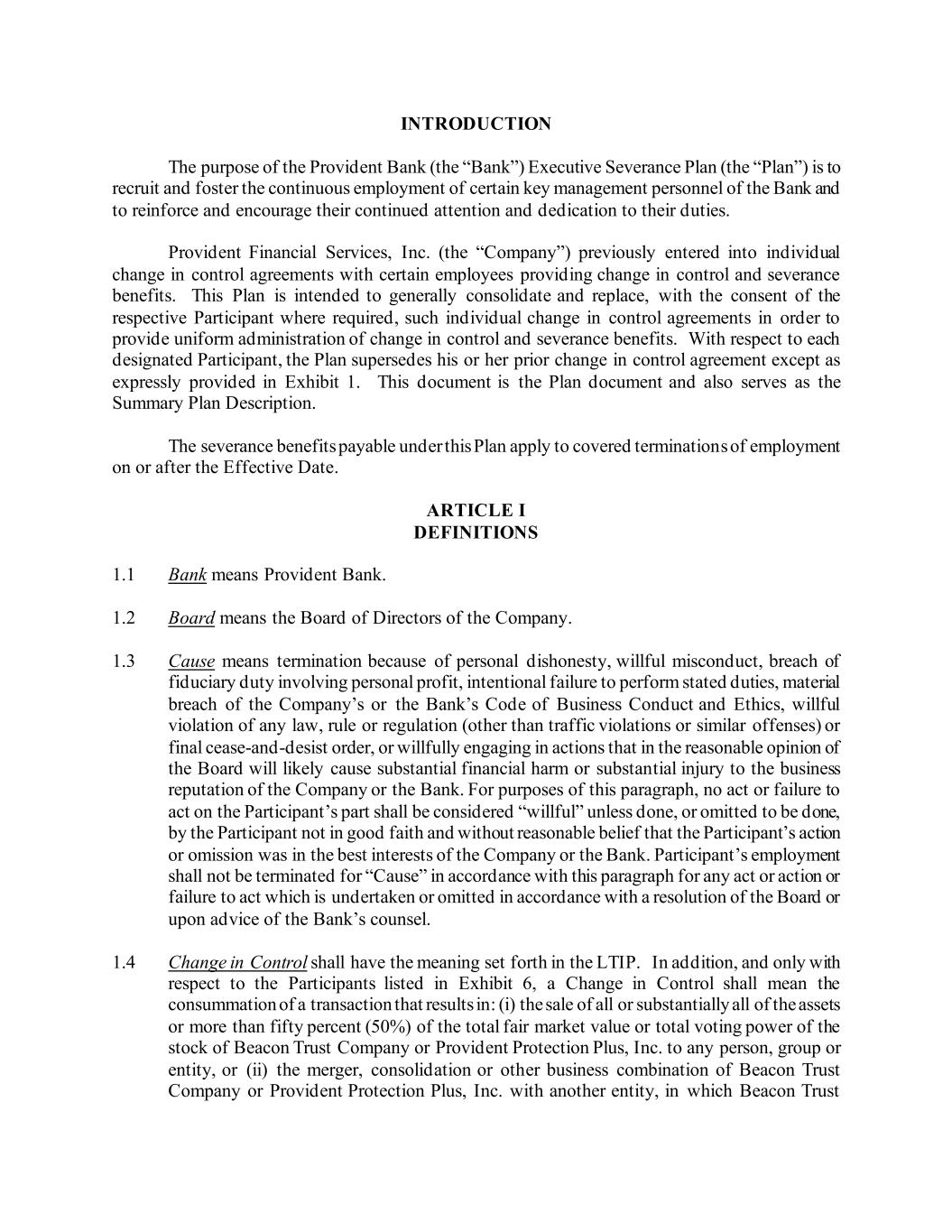
INTRODUCTION The purpose of the Provident Bank (the “Bank”) Executive Severance Plan (the “Plan”) is to recruit and foster the continuous employment of certain key management personnel of the Bank and to reinforce and encourage their continued attention and dedication to their duties. Provident Financial Services, Inc. (the “Company”) previously entered into individual change in control agreements with certain employees providing change in control and severance benefits. This Plan is intended to generally consolidate and replace, with the consent of the respective Participant where required, such individual change in control agreements in order to provide uniform administration of change in control and severance benefits. With respect to each designated Participant, the Plan supersedes his or her prior change in control agreement except as expressly provided in Exhibit 1. This document is the Plan document and also serves as the Summary Plan Description. The severance benefits payable under this Plan apply to covered terminations of employment on or after the Effective Date. ARTICLE I DEFINITIONS 1.1 Bank means Provident Bank. 1.2 Board means the Board of Directors of the Company. 1.3 Cause means termination because of personal dishonesty, willful misconduct, breach of fiduciary duty involving personal profit, intentional failure to perform stated duties, material breach of the Company’s or the Bank’s Code of Business Conduct and Ethics, willful violation of any law, rule or regulation (other than traffic violations or similar offenses) or final cease-and-desist order, or willfully engaging in actions that in the reasonable opinion of the Board will likely cause substantial financial harm or substantial injury to the business reputation of the Company or the Bank. For purposes of this paragraph, no act or failure to act on the Participant’s part shall be considered “willful” unless done, or omitted to be done, by the Participant not in good faith and without reasonable belief that the Participant’s action or omission was in the best interests of the Company or the Bank. Participant’s employment shall not be terminated for “Cause” in accordance with this paragraph for any act or action or failure to act which is undertaken or omitted in accordance with a resolution of the Board or upon advice of the Bank’s counsel. 1.4 Change in Control shall have the meaning set forth in the LTIP. In addition, and only with respect to the Participants listed in Exhibit 6, a Change in Control shall mean the consummation of a transaction that results in: (i) the sale of all or substantially all of the assets or more than fifty percent (50%) of the total fair market value or total voting power of the stock of Beacon Trust Company or Provident Protection Plus, Inc. to any person, group or entity, or (ii) the merger, consolidation or other business combination of Beacon Trust Company or Provident Protection Plus, Inc. with another entity, in which Beacon Trust
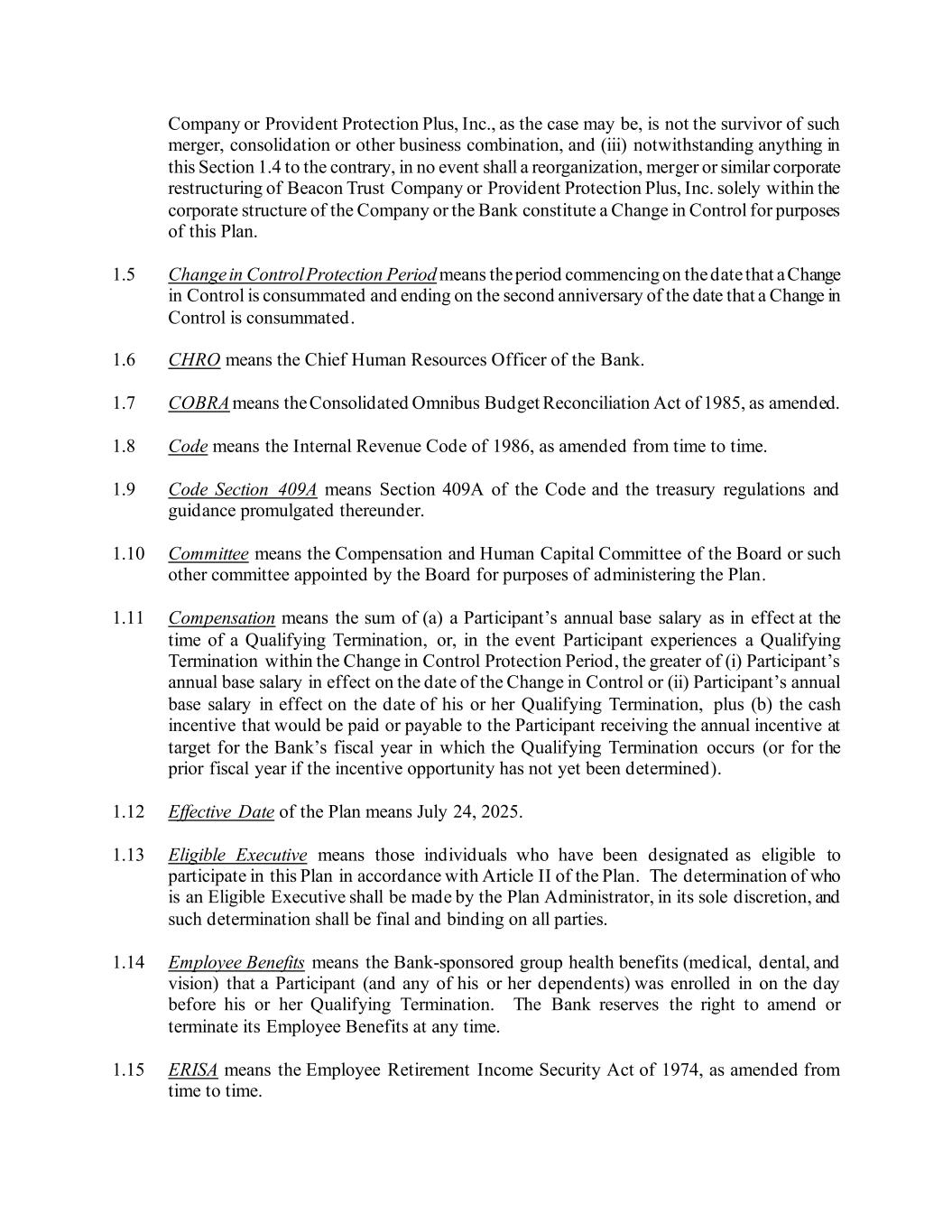
Company or Provident Protection Plus, Inc., as the case may be, is not the survivor of such merger, consolidation or other business combination, and (iii) notwithstanding anything in this Section 1.4 to the contrary, in no event shall a reorganization, merger or similar corporate restructuring of Beacon Trust Company or Provident Protection Plus, Inc. solely within the corporate structure of the Company or the Bank constitute a Change in Control for purposes of this Plan. 1.5 Change in Control Protection Period means the period commencing on the date that a Change in Control is consummated and ending on the second anniversary of the date that a Change in Control is consummated. 1.6 CHRO means the Chief Human Resources Officer of the Bank. 1.7 COBRA means the Consolidated Omnibus Budget Reconciliation Act of 1985, as amended. 1.8 Code means the Internal Revenue Code of 1986, as amended from time to time. 1.9 Code Section 409A means Section 409A of the Code and the treasury regulations and guidance promulgated thereunder. 1.10 Committee means the Compensation and Human Capital Committee of the Board or such other committee appointed by the Board for purposes of administering the Plan. 1.11 Compensation means the sum of (a) a Participant’s annual base salary as in effect at the time of a Qualifying Termination, or, in the event Participant experiences a Qualifying Termination within the Change in Control Protection Period, the greater of (i) Participant’s annual base salary in effect on the date of the Change in Control or (ii) Participant’s annual base salary in effect on the date of his or her Qualifying Termination, plus (b) the cash incentive that would be paid or payable to the Participant receiving the annual incentive at target for the Bank’s fiscal year in which the Qualifying Termination occurs (or for the prior fiscal year if the incentive opportunity has not yet been determined). 1.12 Effective Date of the Plan means July 24, 2025. 1.13 Eligible Executive means those individuals who have been designated as eligible to participate in this Plan in accordance with Article II of the Plan. The determination of who is an Eligible Executive shall be made by the Plan Administrator, in its sole discretion, and such determination shall be final and binding on all parties. 1.14 Employee Benefits means the Bank-sponsored group health benefits (medical, dental, and vision) that a Participant (and any of his or her dependents) was enrolled in on the day before his or her Qualifying Termination. The Bank reserves the right to amend or terminate its Employee Benefits at any time. 1.15 ERISA means the Employee Retirement Income Security Act of 1974, as amended from time to time.

1.16 General Release means a Participant’s general waiver and release of all claims as required by the Bank as a condition of receiving payments and benefits under this Plan, which general release shall be substantially in the form attached as Exhibit 4. 1.17 Good Reason shall have the meaning set forth in the LTIP, and in addition shall require that a Participant give notice of the existence of the Good Reason condition within 90 days after the condition first occurs, and the Company or Bank, as applicable, shall have at least 30 days to cure the condition. 1.18 LTIP means the Provident Financial Services, Inc. 2019 Long Term Incentive Plan, as may be amended from time to time, or such successor plan. 1.19 Participant means an Eligible Executive who has satisfied the eligibility requirements of Article II hereof and who is listed on Exhibit 1 hereto, as such Exhibit 1 may be amended from time to time by the Plan Administrator. 1.20 Participation Notice means a notice provided to an Eligible Executive in the form specified by the Plan Administrator, which will be substantially similar to that set forth in Exhibit 2 hereto. 1.21 Plan means this Provident Bank Executive Severance Plan, as may be amended from time to time. 1.22 Plan Administrator means the Committee. 1.23 Plan Year means the period from the Effective Date through December 31, 2025, and thereafter, the calendar year beginning each January 1. 1.24 Qualifying Termination means: (a) Prior to a Change in Control Protection Period, a Participant’s termination of employment by the Bank without Cause; or (b) on or after a Change in Control Protection Period, a Participant’s termination of employment for Good Reason or a termination of employment by the Bank without Cause. A termination of employment for any reason other than a reason in the foregoing sentence shall not constitute a Qualifying Termination for purposes of this Plan. ARTICLE II ELIGIBILITY AND PARTICIPATION The Plan Administrator shall designate those Eligible Executives who will be Participants in the Plan and the names and titles of the initial Eligible Executives are provided on Exhibit 1 hereto. Each Eligible Executive shall receive a Participation Notice and a restrictive covenant agreement, which will be substantially similar to that set forth in Exhibits 2 and 3 hereto. An Eligible Executive shall not become a Participant unless and until he or she signs and returns the Participation Notice and restrictive covenant agreement within 30 days of receipt. Subject to
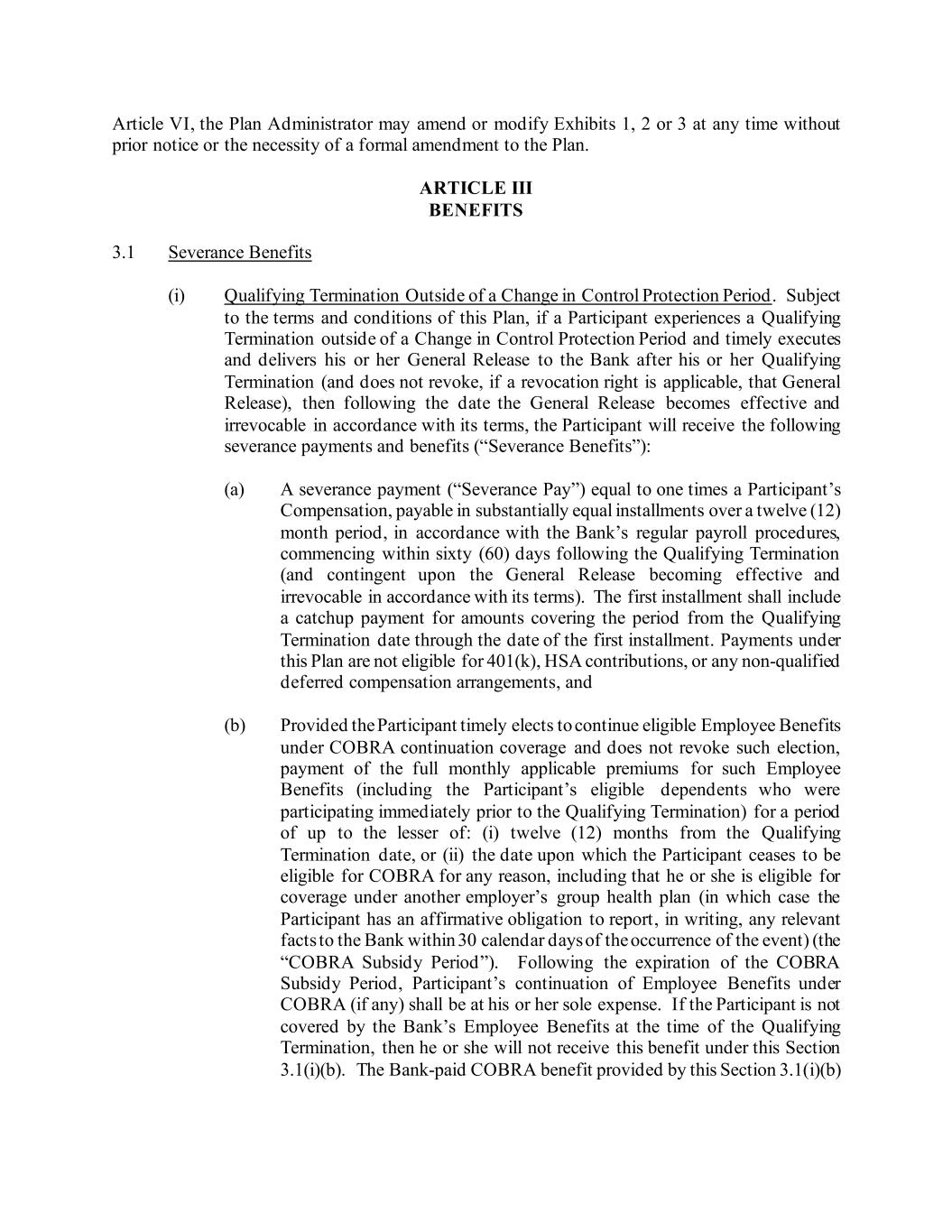
Article VI, the Plan Administrator may amend or modify Exhibits 1, 2 or 3 at any time without prior notice or the necessity of a formal amendment to the Plan. ARTICLE III BENEFITS 3.1 Severance Benefits (i) Qualifying Termination Outside of a Change in Control Protection Period. Subject to the terms and conditions of this Plan, if a Participant experiences a Qualifying Termination outside of a Change in Control Protection Period and timely executes and delivers his or her General Release to the Bank after his or her Qualifying Termination (and does not revoke, if a revocation right is applicable, that General Release), then following the date the General Release becomes effective and irrevocable in accordance with its terms, the Participant will receive the following severance payments and benefits (“Severance Benefits”): (a) A severance payment (“Severance Pay”) equal to one times a Participant’s Compensation, payable in substantially equal installments over a twelve (12) month period, in accordance with the Bank’s regular payroll procedures, commencing within sixty (60) days following the Qualifying Termination (and contingent upon the General Release becoming effective and irrevocable in accordance with its terms). The first installment shall include a catchup payment for amounts covering the period from the Qualifying Termination date through the date of the first installment. Payments under this Plan are not eligible for 401(k), HSA contributions, or any non-qualified deferred compensation arrangements, and (b) Provided the Participant timely elects to continue eligible Employee Benefits under COBRA continuation coverage and does not revoke such election, payment of the full monthly applicable premiums for such Employee Benefits (including the Participant’s eligible dependents who were participating immediately prior to the Qualifying Termination) for a period of up to the lesser of: (i) twelve (12) months from the Qualifying Termination date, or (ii) the date upon which the Participant ceases to be eligible for COBRA for any reason, including that he or she is eligible for coverage under another employer’s group health plan (in which case the Participant has an affirmative obligation to report, in writing, any relevant facts to the Bank within 30 calendar days of the occurrence of the event) (the “COBRA Subsidy Period”). Following the expiration of the COBRA Subsidy Period, Participant’s continuation of Employee Benefits under COBRA (if any) shall be at his or her sole expense. If the Participant is not covered by the Bank’s Employee Benefits at the time of the Qualifying Termination, then he or she will not receive this benefit under this Section 3.1(i)(b). The Bank-paid COBRA benefit provided by this Section 3.1(i)(b)
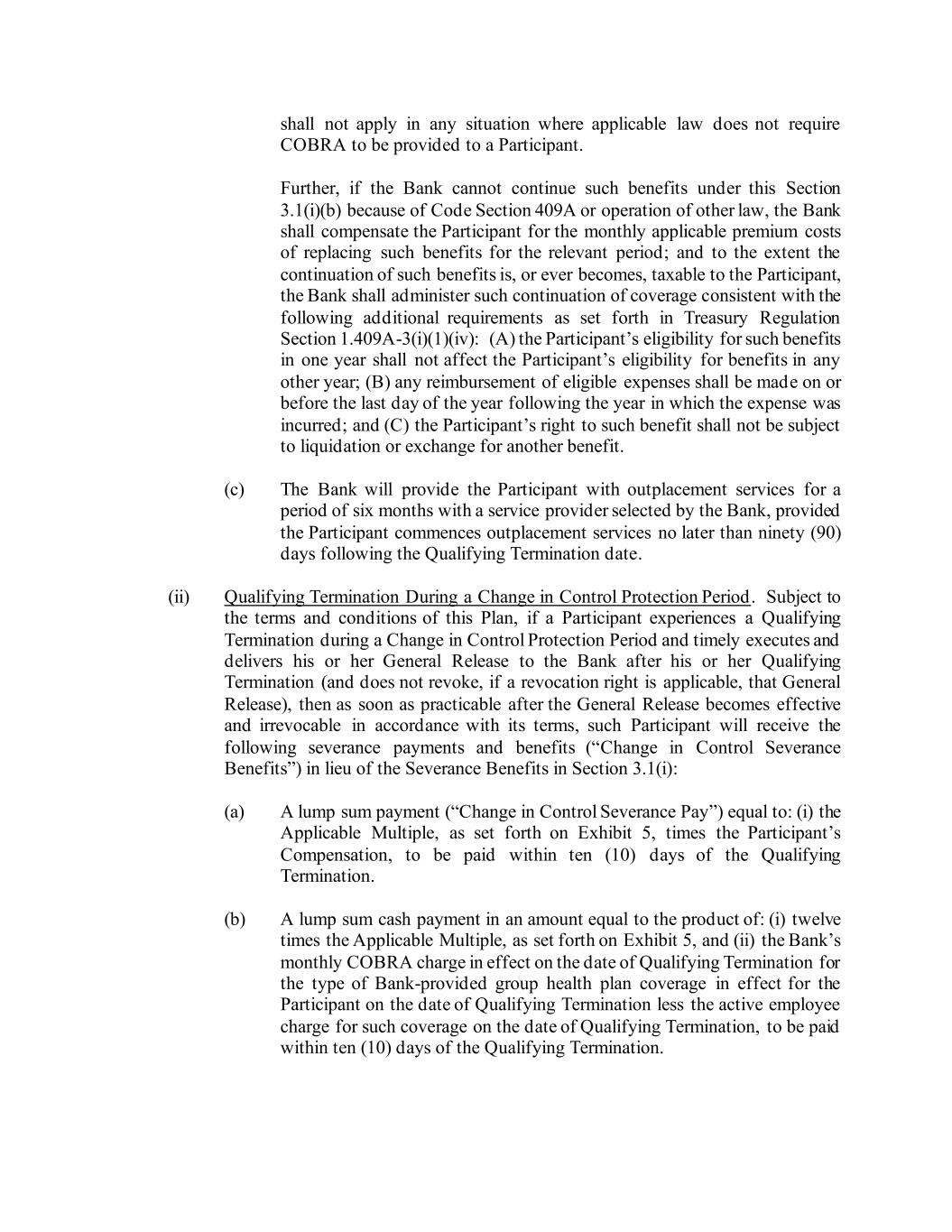
shall not apply in any situation where applicable law does not require COBRA to be provided to a Participant. Further, if the Bank cannot continue such benefits under this Section 3.1(i)(b) because of Code Section 409A or operation of other law, the Bank shall compensate the Participant for the monthly applicable premium costs of replacing such benefits for the relevant period; and to the extent the continuation of such benefits is, or ever becomes, taxable to the Participant, the Bank shall administer such continuation of coverage consistent with the following additional requirements as set forth in Treasury Regulation Section 1.409A-3(i)(1)(iv): (A) the Participant’s eligibility for such benefits in one year shall not affect the Participant’s eligibility for benefits in any other year; (B) any reimbursement of eligible expenses shall be made on or before the last day of the year following the year in which the expense was incurred; and (C) the Participant’s right to such benefit shall not be subject to liquidation or exchange for another benefit. (c) The Bank will provide the Participant with outplacement services for a period of six months with a service provider selected by the Bank, provided the Participant commences outplacement services no later than ninety (90) days following the Qualifying Termination date. (ii) Qualifying Termination During a Change in Control Protection Period. Subject to the terms and conditions of this Plan, if a Participant experiences a Qualifying Termination during a Change in Control Protection Period and timely executes and delivers his or her General Release to the Bank after his or her Qualifying Termination (and does not revoke, if a revocation right is applicable, that General Release), then as soon as practicable after the General Release becomes effective and irrevocable in accordance with its terms, such Participant will receive the following severance payments and benefits (“Change in Control Severance Benefits”) in lieu of the Severance Benefits in Section 3.1(i): (a) A lump sum payment (“Change in Control Severance Pay”) equal to: (i) the Applicable Multiple, as set forth on Exhibit 5, times the Participant’s Compensation, to be paid within ten (10) days of the Qualifying Termination. (b) A lump sum cash payment in an amount equal to the product of: (i) twelve times the Applicable Multiple, as set forth on Exhibit 5, and (ii) the Bank’s monthly COBRA charge in effect on the date of Qualifying Termination for the type of Bank-provided group health plan coverage in effect for the Participant on the date of Qualifying Termination less the active employee charge for such coverage on the date of Qualifying Termination, to be paid within ten (10) days of the Qualifying Termination.

(c) The Bank will provide the Participant with outplacement services for a period of six months with a service provider selected by the Bank, provided the Participant commences outplacement services no later than ninety (90) days following the Qualifying Termination date. (iii) If a Participant fails to comply with the terms of the General Release, violates the terms of any restrictive covenant agreement or provision, or the Bank determines that grounds existed at the time of the Qualifying Termination to terminate him or her for Cause, the Bank reserves the right to withhold and terminate any Severance Benefits, Change in Control Severance Benefits, or any other benefits under this Plan and to require the Participant to repay the gross amount that he or she may have previously received under the Plan. (iv) The benefits provided under the Plan are intended to satisfy, to the greatest extent possible, and not to provide benefits duplicative of, any and all statutory, contractual, plan, program, policy or other obligations or arrangements of the Bank in respect of compensation and benefits that may arise out of a Qualifying Termination, and the Plan Administrator will so construe and implement the terms of the Plan. Reductions may be applied on a retroactive basis, with benefits previously provided being recharacterized as benefits pursuant to the Bank’s statutory or other contractual obligations. The payments pursuant to the Plan are in addition to, and not in lieu of, any unpaid salary or employee welfare benefits to which a Participant may be entitled for the period ending with the Participant’s Qualifying Termination. 3.2 General Release of All Claims. As a condition precedent to receiving the benefits described in this Plan, a Participant will be required to timely execute and not revoke (if revocation right is applicable) a General Release in a form satisfactory to the Bank. If a Participant fails or refuses to timely execute a General Release or revokes it (if a revocation right is applicable), he or she shall not be entitled to receive any Severance Benefits, Change in Control Severance Benefits, or any other benefits under this Plan. Any General Release may be incorporated into a termination agreement or other agreement with the Participant at the discretion of the Plan Administrator. 3.3 Death Prior to Receipt of Severance Benefits or Change in Control Severance Benefits. If a Participant dies after incurring a Qualifying Termination but before he or she receives his or her full Severance Benefits or Change in Control Severance Benefits, the Bank will pay the Participant’s unpaid Severance Pay or Change in Control Severance Pay (but not the value of any other benefits that may otherwise be provided by this Plan) in a lump sum to his or her surviving spouse or, if none, to his or her estate; provided, however, that the spouse, or his or her estate, as the case may be, have complied with the terms of the Plan (including execution and non-revocation of a General Release if Participant has not executed such General Release prior to his or her death). Such payment shall be made within sixty (60) days of the Bank’s notification of the Participant’s death, provided the General Release has been timely signed and not revoked. The Bank may require proof of the Participant’s death.

3.4 Equity Awards. The Plan does not affect the terms of any outstanding equity awards. The treatment of any outstanding equity awards shall be determined in accordance with the terms of the Company equity plan or plans under which they were granted and any applicable award agreements. 3.5 Restrictive Covenant Agreement. In consideration of an Eligible Executive becoming a Participant in this Plan, the Eligible Executive shall enter into the Restrictive Covenant Agreement set forth on Exhibit 3. ARTICLE IV CLAIMS PROCEDURE 4.1 Claims. (i) A Claimant (a Participant, or his or her authorized representative) who believes that he or she is entitled to benefits under this Plan that have not been received may submit a written claim for benefits to the attention of the CHRO at the address set forth under General Plan Information. (ii) Claims shall indicate the specific provisions of the Plan relied upon and must set forth in reasonable detail all relevant facts and circumstances to support a claim for benefits under the Plan. (iii) A Claimant must assert a claim for benefits under the Plan within ninety (90) days of the Qualifying Termination date or the claim shall be deemed waived. 4.2 Disposition of Claim. (i) The CHRO shall make the initial determination as to any claim and give the Claimant notice thereof within ninety (90) days after receipt of the claim, unless special circumstances require further time for processing the claim, not to exceed ninety (90) additional days, as determined by the CHRO. (ii) If the CHRO determines that it will need additional time to process the claim, it shall give the Claimant written notice of this need prior to expiration of the initial 90-day period. The notice shall state the special circumstances requiring an extension of time and the date by which the CHRO expects to reach a decision. (iii) If the CHRO wholly or partially denies the claim, the notice of denial shall be set forth in a manner calculated to be understood by the Claimant, and shall include the following: (a) The specific reason for denial;

(b) Specific reference to pertinent Plan provision(s) on which the denial is based; (c) A description of any additional material or information necessary for the Claimant to perfect the claim and an explanation of why such information or material is necessary; (d) A description of the Plan’s review procedures and the time limits applicable to such procedures; and (e) A statement of the Claimant’s right to bring a civil action under Section 502(a) of ERISA following an adverse benefit determination on review (if applicable). 4.3 Request for Review. Within sixty (60) days after notification that the claim is wholly or partially denied, the Claimant may file with the Plan Administrator a written request for review of the decision. The Plan Administrator shall provide the Claimant an opportunity to review all pertinent documents relating to the claim and to submit written comments, documents, records and other information relating to the claim for benefits. The costs of any representative for the Claimant shall be paid by the Claimant. The Plan Administrator’s review shall take into account all materials submitted by the Claimant, without regard to whether such information was submitted or considered in the initial benefit determination. 4.4 Decision on Review. (i) Within sixty (60) calendar days after receipt of a request for review of the claim (unless special circumstances require further time for processing the review, not to exceed sixty (60) additional days, as determined by the Plan Administrator), the Plan Administrator shall make a final determination and give notice to the Claimant of its decision, which shall include the specific reasons for the decision, written in a manner calculated to be understood by the Claimant, and specific references to the pertinent Plan provisions on which the decision is based. If adverse to the Claimant, the decision shall include a statement that the Claimant is entitled to receive, free of charge, reasonable access to, and copies of, all documents, records and other information relevant to the claim, and a statement of the Claimant’s right to bring an action under Section 502(a) of ERISA (if applicable). (ii) The decision of the Plan Administrator on appeal, including (but not limited to) questions of construction, interpretation and administration shall be final, conclusive and binding on all persons having an interest in or under the Plan. Any determination made by the Plan Administrator shall be given deference in the event the determination is subject to judicial review and shall be overturned by a court of law only if it is arbitrary and capricious. 4.5 Time Bar to Legal Action. No legal action may be commenced or maintained against the Plan prior to the Claimant’s exhaustion of the claims procedures set forth in this Article
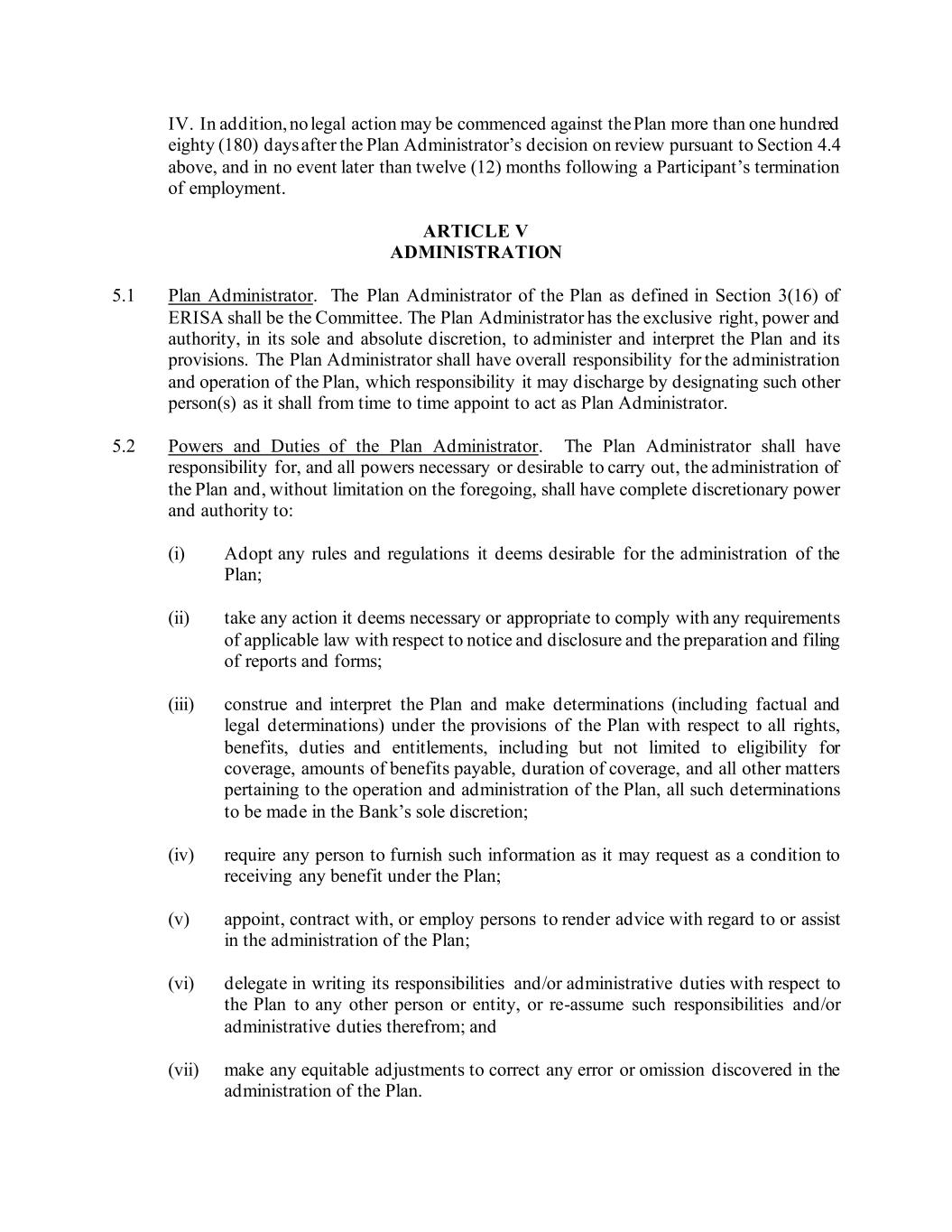
IV. In addition, no legal action may be commenced against the Plan more than one hundred eighty (180) days after the Plan Administrator’s decision on review pursuant to Section 4.4 above, and in no event later than twelve (12) months following a Participant’s termination of employment. ARTICLE V ADMINISTRATION 5.1 Plan Administrator. The Plan Administrator of the Plan as defined in Section 3(16) of ERISA shall be the Committee. The Plan Administrator has the exclusive right, power and authority, in its sole and absolute discretion, to administer and interpret the Plan and its provisions. The Plan Administrator shall have overall responsibility for the administration and operation of the Plan, which responsibility it may discharge by designating such other person(s) as it shall from time to time appoint to act as Plan Administrator. 5.2 Powers and Duties of the Plan Administrator. The Plan Administrator shall have responsibility for, and all powers necessary or desirable to carry out, the administration of the Plan and, without limitation on the foregoing, shall have complete discretionary power and authority to: (i) Adopt any rules and regulations it deems desirable for the administration of the Plan; (ii) take any action it deems necessary or appropriate to comply with any requirements of applicable law with respect to notice and disclosure and the preparation and filing of reports and forms; (iii) construe and interpret the Plan and make determinations (including factual and legal determinations) under the provisions of the Plan with respect to all rights, benefits, duties and entitlements, including but not limited to eligibility for coverage, amounts of benefits payable, duration of coverage, and all other matters pertaining to the operation and administration of the Plan, all such determinations to be made in the Bank’s sole discretion; (iv) require any person to furnish such information as it may request as a condition to receiving any benefit under the Plan; (v) appoint, contract with, or employ persons to render advice with regard to or assist in the administration of the Plan; (vi) delegate in writing its responsibilities and/or administrative duties with respect to the Plan to any other person or entity, or re-assume such responsibilities and/or administrative duties therefrom; and (vii) make any equitable adjustments to correct any error or omission discovered in the administration of the Plan.
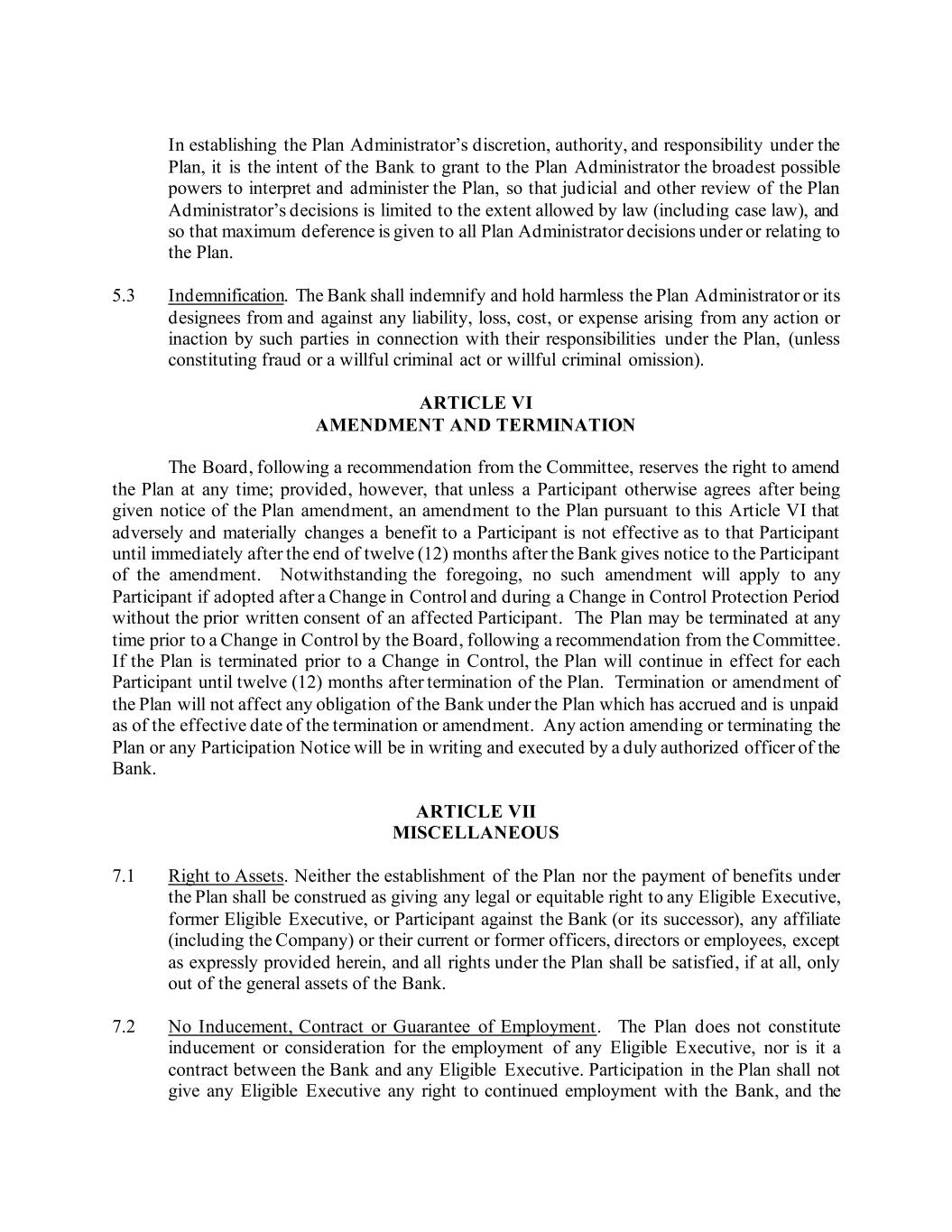
In establishing the Plan Administrator’s discretion, authority, and responsibility under the Plan, it is the intent of the Bank to grant to the Plan Administrator the broadest possible powers to interpret and administer the Plan, so that judicial and other review of the Plan Administrator’s decisions is limited to the extent allowed by law (including case law), and so that maximum deference is given to all Plan Administrator decisions under or relating to the Plan. 5.3 Indemnification. The Bank shall indemnify and hold harmless the Plan Administrator or its designees from and against any liability, loss, cost, or expense arising from any action or inaction by such parties in connection with their responsibilities under the Plan, (unless constituting fraud or a willful criminal act or willful criminal omission). ARTICLE VI AMENDMENT AND TERMINATION The Board, following a recommendation from the Committee, reserves the right to amend the Plan at any time; provided, however, that unless a Participant otherwise agrees after being given notice of the Plan amendment, an amendment to the Plan pursuant to this Article VI that adversely and materially changes a benefit to a Participant is not effective as to that Participant until immediately after the end of twelve (12) months after the Bank gives notice to the Participant of the amendment. Notwithstanding the foregoing, no such amendment will apply to any Participant if adopted after a Change in Control and during a Change in Control Protection Period without the prior written consent of an affected Participant. The Plan may be terminated at any time prior to a Change in Control by the Board, following a recommendation from the Committee. If the Plan is terminated prior to a Change in Control, the Plan will continue in effect for each Participant until twelve (12) months after termination of the Plan. Termination or amendment of the Plan will not affect any obligation of the Bank under the Plan which has accrued and is unpaid as of the effective date of the termination or amendment. Any action amending or terminating the Plan or any Participation Notice will be in writing and executed by a duly authorized officer of the Bank. ARTICLE VII MISCELLANEOUS 7.1 Right to Assets. Neither the establishment of the Plan nor the payment of benefits under the Plan shall be construed as giving any legal or equitable right to any Eligible Executive, former Eligible Executive, or Participant against the Bank (or its successor), any affiliate (including the Company) or their current or former officers, directors or employees, except as expressly provided herein, and all rights under the Plan shall be satisfied, if at all, only out of the general assets of the Bank. 7.2 No Inducement, Contract or Guarantee of Employment. The Plan does not constitute inducement or consideration for the employment of any Eligible Executive, nor is it a contract between the Bank and any Eligible Executive. Participation in the Plan shall not give any Eligible Executive any right to continued employment with the Bank, and the
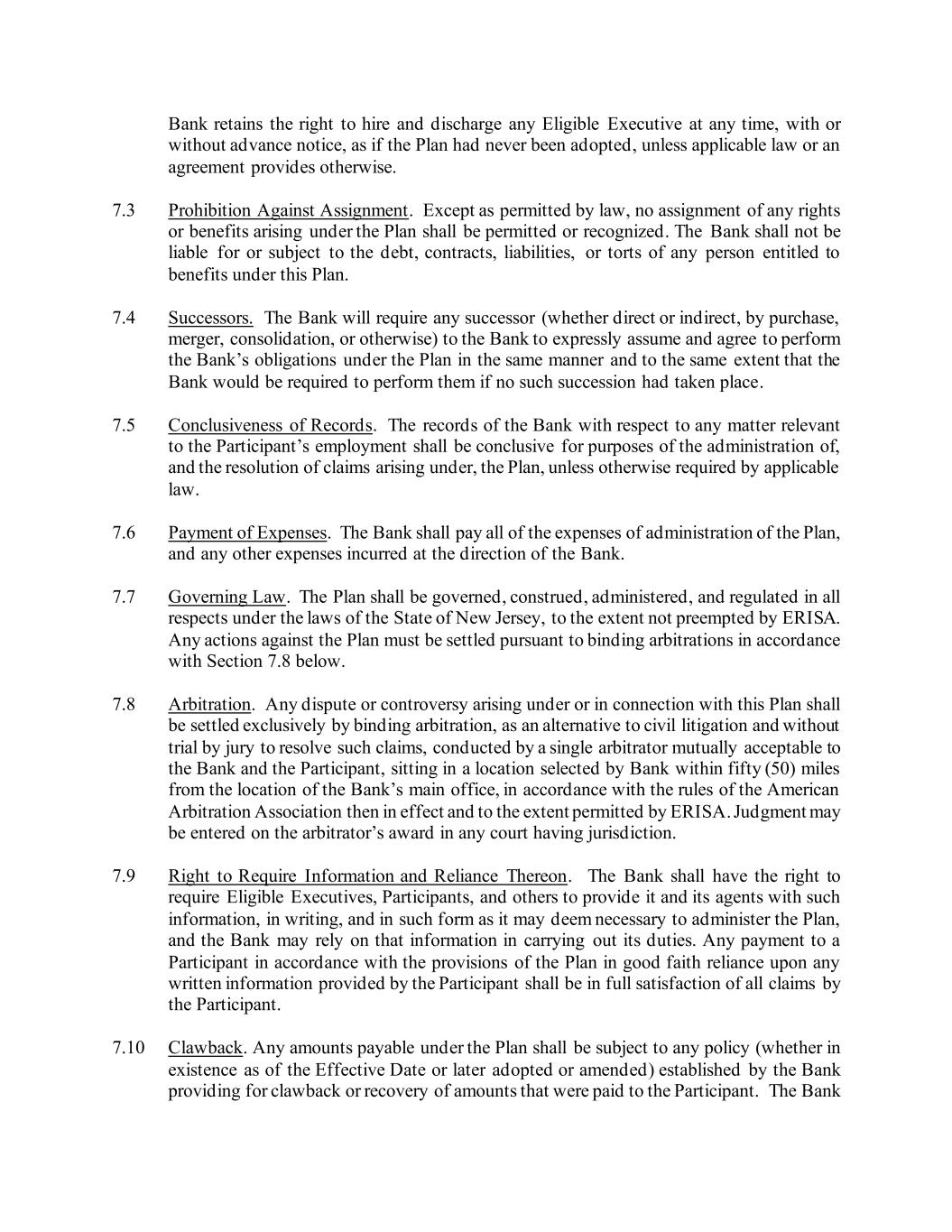
Bank retains the right to hire and discharge any Eligible Executive at any time, with or without advance notice, as if the Plan had never been adopted, unless applicable law or an agreement provides otherwise. 7.3 Prohibition Against Assignment. Except as permitted by law, no assignment of any rights or benefits arising under the Plan shall be permitted or recognized. The Bank shall not be liable for or subject to the debt, contracts, liabilities, or torts of any person entitled to benefits under this Plan. 7.4 Successors. The Bank will require any successor (whether direct or indirect, by purchase, merger, consolidation, or otherwise) to the Bank to expressly assume and agree to perform the Bank’s obligations under the Plan in the same manner and to the same extent that the Bank would be required to perform them if no such succession had taken place. 7.5 Conclusiveness of Records. The records of the Bank with respect to any matter relevant to the Participant’s employment shall be conclusive for purposes of the administration of, and the resolution of claims arising under, the Plan, unless otherwise required by applicable law. 7.6 Payment of Expenses. The Bank shall pay all of the expenses of administration of the Plan, and any other expenses incurred at the direction of the Bank. 7.7 Governing Law. The Plan shall be governed, construed, administered, and regulated in all respects under the laws of the State of New Jersey, to the extent not preempted by ERISA. Any actions against the Plan must be settled pursuant to binding arbitrations in accordance with Section 7.8 below. 7.8 Arbitration. Any dispute or controversy arising under or in connection with this Plan shall be settled exclusively by binding arbitration, as an alternative to civil litigation and without trial by jury to resolve such claims, conducted by a single arbitrator mutually acceptable to the Bank and the Participant, sitting in a location selected by Bank within fifty (50) miles from the location of the Bank’s main office, in accordance with the rules of the American Arbitration Association then in effect and to the extent permitted by ERISA. Judgment may be entered on the arbitrator’s award in any court having jurisdiction. 7.9 Right to Require Information and Reliance Thereon. The Bank shall have the right to require Eligible Executives, Participants, and others to provide it and its agents with such information, in writing, and in such form as it may deem necessary to administer the Plan, and the Bank may rely on that information in carrying out its duties. Any payment to a Participant in accordance with the provisions of the Plan in good faith reliance upon any written information provided by the Participant shall be in full satisfaction of all claims by the Participant. 7.10 Clawback. Any amounts payable under the Plan shall be subject to any policy (whether in existence as of the Effective Date or later adopted or amended) established by the Bank providing for clawback or recovery of amounts that were paid to the Participant. The Bank
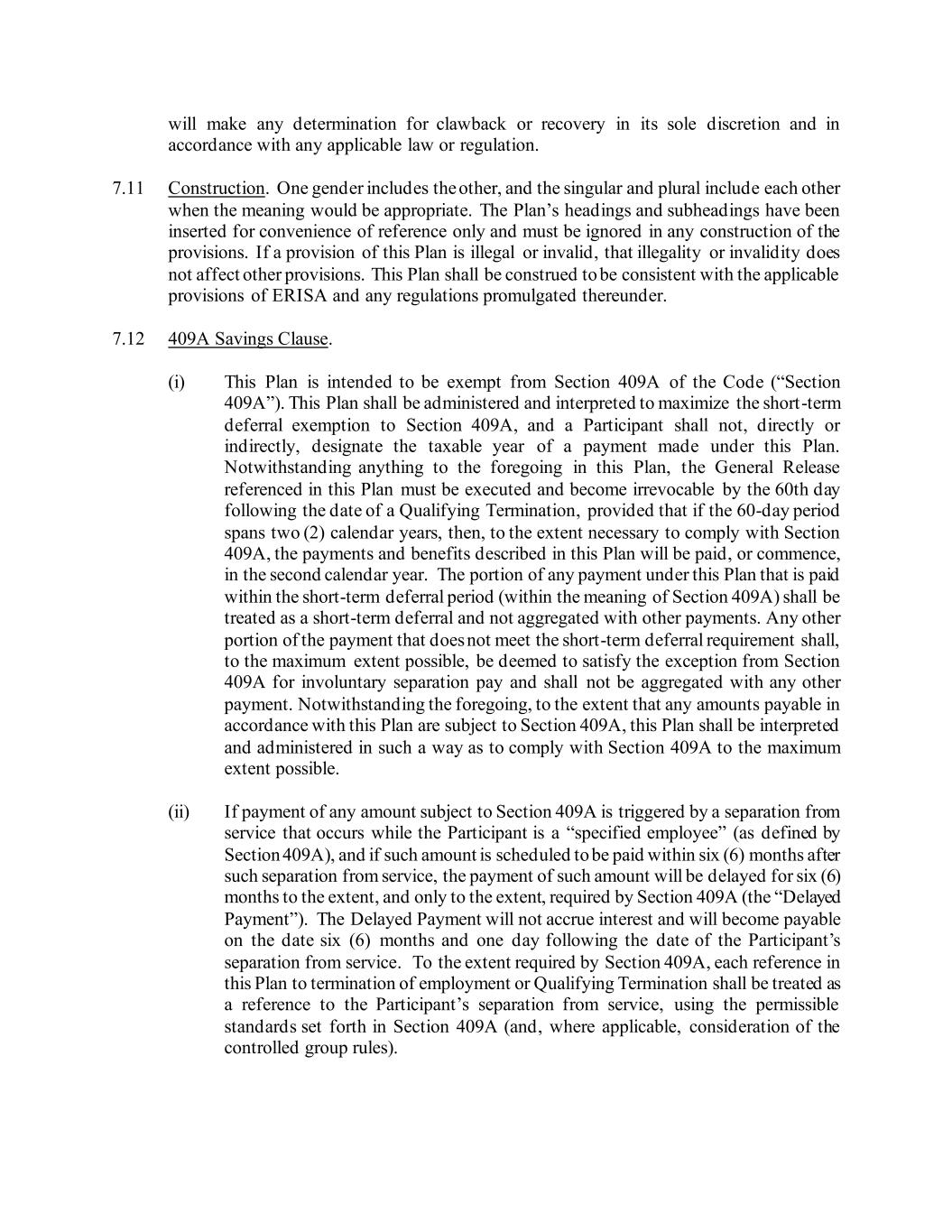
will make any determination for clawback or recovery in its sole discretion and in accordance with any applicable law or regulation. 7.11 Construction. One gender includes the other, and the singular and plural include each other when the meaning would be appropriate. The Plan’s headings and subheadings have been inserted for convenience of reference only and must be ignored in any construction of the provisions. If a provision of this Plan is illegal or invalid, that illegality or invalidity does not affect other provisions. This Plan shall be construed to be consistent with the applicable provisions of ERISA and any regulations promulgated thereunder. 7.12 409A Savings Clause. (i) This Plan is intended to be exempt from Section 409A of the Code (“Section 409A”). This Plan shall be administered and interpreted to maximize the short-term deferral exemption to Section 409A, and a Participant shall not, directly or indirectly, designate the taxable year of a payment made under this Plan. Notwithstanding anything to the foregoing in this Plan, the General Release referenced in this Plan must be executed and become irrevocable by the 60th day following the date of a Qualifying Termination, provided that if the 60-day period spans two (2) calendar years, then, to the extent necessary to comply with Section 409A, the payments and benefits described in this Plan will be paid, or commence, in the second calendar year. The portion of any payment under this Plan that is paid within the short-term deferral period (within the meaning of Section 409A) shall be treated as a short-term deferral and not aggregated with other payments. Any other portion of the payment that does not meet the short-term deferral requirement shall, to the maximum extent possible, be deemed to satisfy the exception from Section 409A for involuntary separation pay and shall not be aggregated with any other payment. Notwithstanding the foregoing, to the extent that any amounts payable in accordance with this Plan are subject to Section 409A, this Plan shall be interpreted and administered in such a way as to comply with Section 409A to the maximum extent possible. (ii) If payment of any amount subject to Section 409A is triggered by a separation from service that occurs while the Participant is a “specified employee” (as defined by Section 409A), and if such amount is scheduled to be paid within six (6) months after such separation from service, the payment of such amount will be delayed for six (6) months to the extent, and only to the extent, required by Section 409A (the “Delayed Payment”). The Delayed Payment will not accrue interest and will become payable on the date six (6) months and one day following the date of the Participant’s separation from service. To the extent required by Section 409A, each reference in this Plan to termination of employment or Qualifying Termination shall be treated as a reference to the Participant’s separation from service, using the permissible standards set forth in Section 409A (and, where applicable, consideration of the controlled group rules).
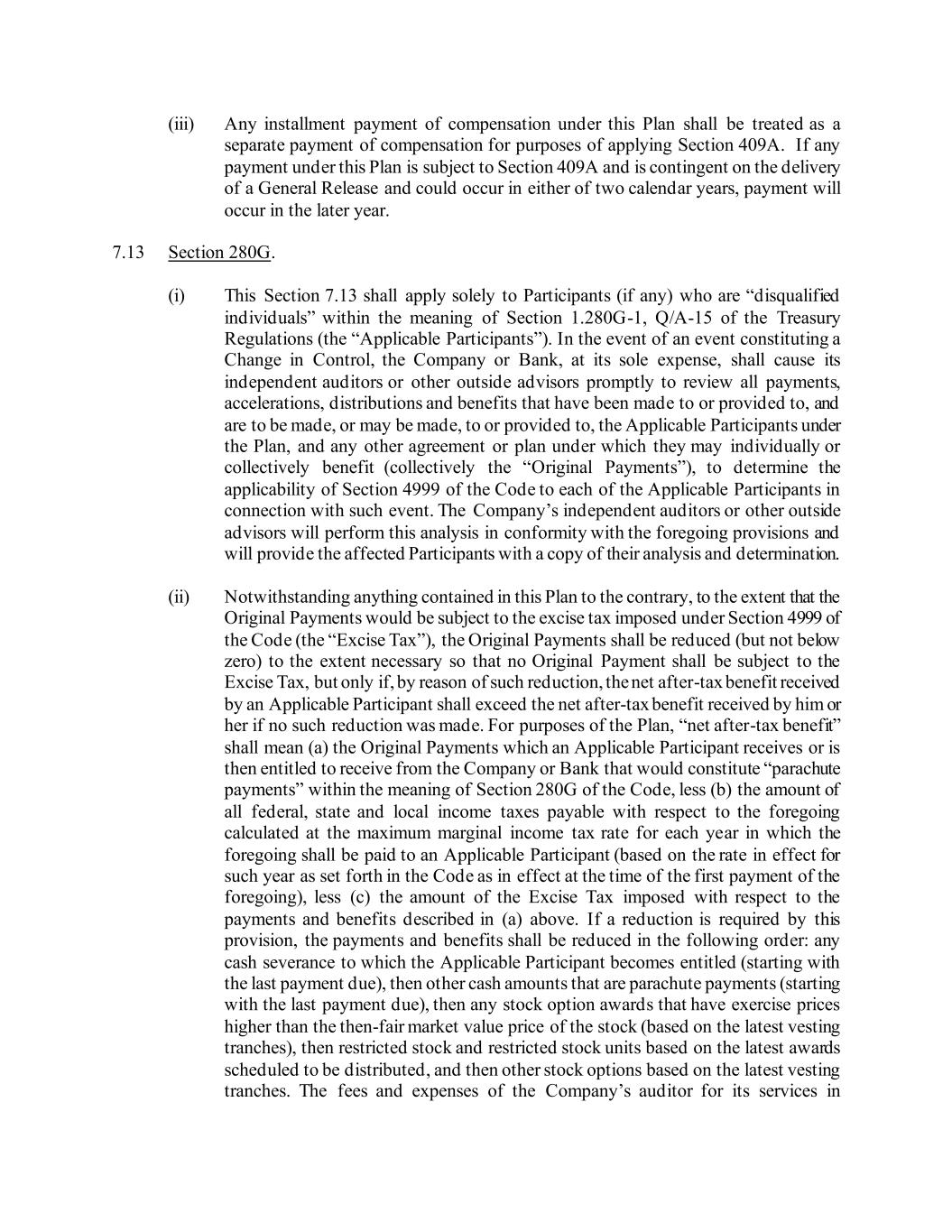
(iii) Any installment payment of compensation under this Plan shall be treated as a separate payment of compensation for purposes of applying Section 409A. If any payment under this Plan is subject to Section 409A and is contingent on the delivery of a General Release and could occur in either of two calendar years, payment will occur in the later year. 7.13 Section 280G. (i) This Section 7.13 shall apply solely to Participants (if any) who are “disqualified individuals” within the meaning of Section 1.280G-1, Q/A-15 of the Treasury Regulations (the “Applicable Participants”). In the event of an event constituting a Change in Control, the Company or Bank, at its sole expense, shall cause its independent auditors or other outside advisors promptly to review all payments, accelerations, distributions and benefits that have been made to or provided to, and are to be made, or may be made, to or provided to, the Applicable Participants under the Plan, and any other agreement or plan under which they may individually or collectively benefit (collectively the “Original Payments”), to determine the applicability of Section 4999 of the Code to each of the Applicable Participants in connection with such event. The Company’s independent auditors or other outside advisors will perform this analysis in conformity with the foregoing provisions and will provide the affected Participants with a copy of their analysis and determination. (ii) Notwithstanding anything contained in this Plan to the contrary, to the extent that the Original Payments would be subject to the excise tax imposed under Section 4999 of the Code (the “Excise Tax”), the Original Payments shall be reduced (but not below zero) to the extent necessary so that no Original Payment shall be subject to the Excise Tax, but only if, by reason of such reduction, the net after-tax benefit received by an Applicable Participant shall exceed the net after-tax benefit received by him or her if no such reduction was made. For purposes of the Plan, “net after-tax benefit” shall mean (a) the Original Payments which an Applicable Participant receives or is then entitled to receive from the Company or Bank that would constitute “parachute payments” within the meaning of Section 280G of the Code, less (b) the amount of all federal, state and local income taxes payable with respect to the foregoing calculated at the maximum marginal income tax rate for each year in which the foregoing shall be paid to an Applicable Participant (based on the rate in effect for such year as set forth in the Code as in effect at the time of the first payment of the foregoing), less (c) the amount of the Excise Tax imposed with respect to the payments and benefits described in (a) above. If a reduction is required by this provision, the payments and benefits shall be reduced in the following order: any cash severance to which the Applicable Participant becomes entitled (starting with the last payment due), then other cash amounts that are parachute payments (starting with the last payment due), then any stock option awards that have exercise prices higher than the then-fair market value price of the stock (based on the latest vesting tranches), then restricted stock and restricted stock units based on the latest awards scheduled to be distributed, and then other stock options based on the latest vesting tranches. The fees and expenses of the Company’s auditor for its services in
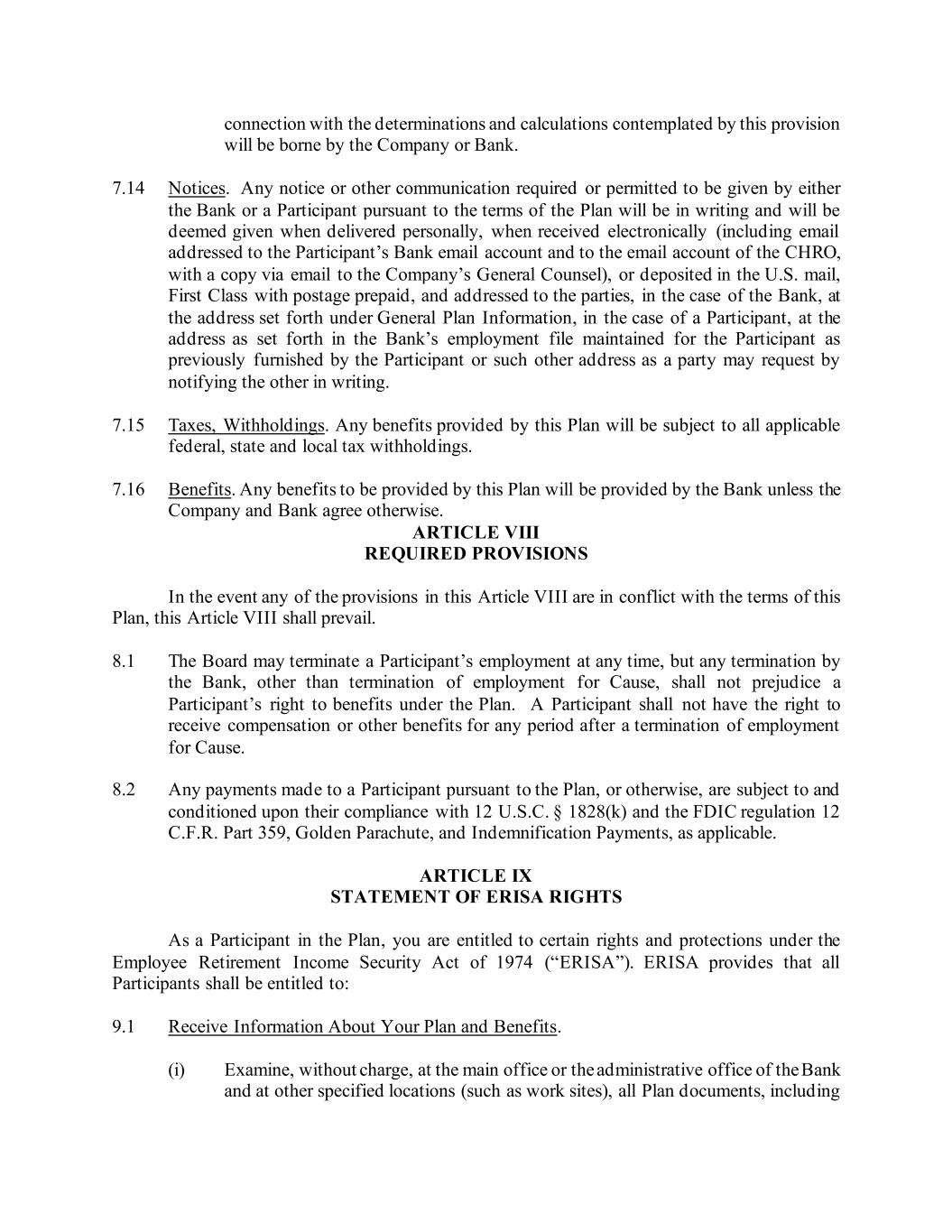
connection with the determinations and calculations contemplated by this provision will be borne by the Company or Bank. 7.14 Notices. Any notice or other communication required or permitted to be given by either the Bank or a Participant pursuant to the terms of the Plan will be in writing and will be deemed given when delivered personally, when received electronically (including email addressed to the Participant’s Bank email account and to the email account of the CHRO, with a copy via email to the Company’s General Counsel), or deposited in the U.S. mail, First Class with postage prepaid, and addressed to the parties, in the case of the Bank, at the address set forth under General Plan Information, in the case of a Participant, at the address as set forth in the Bank’s employment file maintained for the Participant as previously furnished by the Participant or such other address as a party may request by notifying the other in writing. 7.15 Taxes, Withholdings. Any benefits provided by this Plan will be subject to all applicable federal, state and local tax withholdings. 7.16 Benefits. Any benefits to be provided by this Plan will be provided by the Bank unless the Company and Bank agree otherwise. ARTICLE VIII REQUIRED PROVISIONS In the event any of the provisions in this Article VIII are in conflict with the terms of this Plan, this Article VIII shall prevail. 8.1 The Board may terminate a Participant’s employment at any time, but any termination by the Bank, other than termination of employment for Cause, shall not prejudice a Participant’s right to benefits under the Plan. A Participant shall not have the right to receive compensation or other benefits for any period after a termination of employment for Cause. 8.2 Any payments made to a Participant pursuant to the Plan, or otherwise, are subject to and conditioned upon their compliance with 12 U.S.C. § 1828(k) and the FDIC regulation 12 C.F.R. Part 359, Golden Parachute, and Indemnification Payments, as applicable. ARTICLE IX STATEMENT OF ERISA RIGHTS As a Participant in the Plan, you are entitled to certain rights and protections under the Employee Retirement Income Security Act of 1974 (“ERISA”). ERISA provides that all Participants shall be entitled to: 9.1 Receive Information About Your Plan and Benefits. (i) Examine, without charge, at the main office or the administrative office of the Bank and at other specified locations (such as work sites), all Plan documents, including
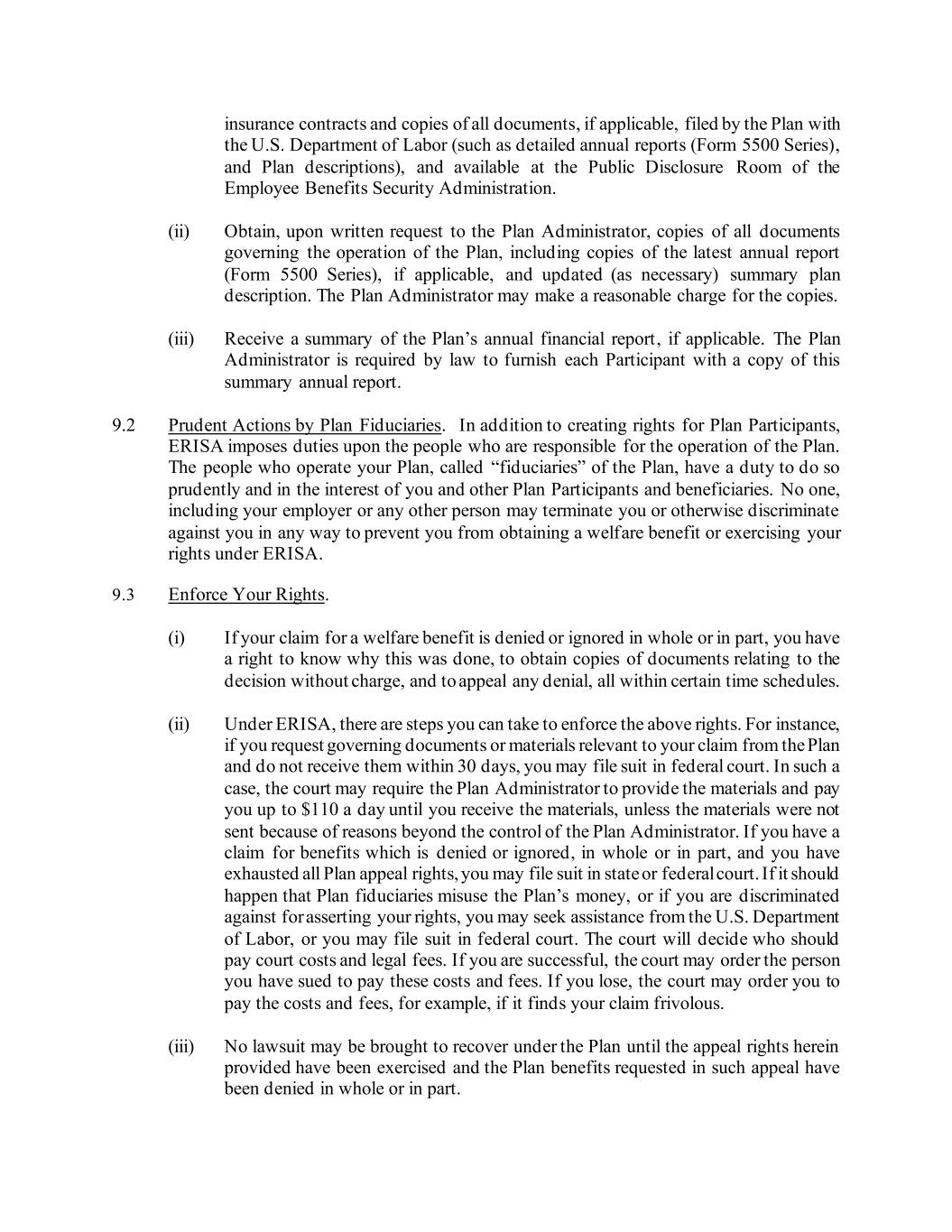
insurance contracts and copies of all documents, if applicable, filed by the Plan with the U.S. Department of Labor (such as detailed annual reports (Form 5500 Series), and Plan descriptions), and available at the Public Disclosure Room of the Employee Benefits Security Administration. (ii) Obtain, upon written request to the Plan Administrator, copies of all documents governing the operation of the Plan, including copies of the latest annual report (Form 5500 Series), if applicable, and updated (as necessary) summary plan description. The Plan Administrator may make a reasonable charge for the copies. (iii) Receive a summary of the Plan’s annual financial report , if applicable. The Plan Administrator is required by law to furnish each Participant with a copy of this summary annual report. 9.2 Prudent Actions by Plan Fiduciaries. In addition to creating rights for Plan Participants, ERISA imposes duties upon the people who are responsible for the operation of the Plan. The people who operate your Plan, called “fiduciaries” of the Plan, have a duty to do so prudently and in the interest of you and other Plan Participants and beneficiaries. No one, including your employer or any other person may terminate you or otherwise discriminate against you in any way to prevent you from obtaining a welfare benefit or exercising your rights under ERISA. 9.3 Enforce Your Rights. (i) If your claim for a welfare benefit is denied or ignored in whole or in part, you have a right to know why this was done, to obtain copies of documents relating to the decision without charge, and to appeal any denial, all within certain time schedules. (ii) Under ERISA, there are steps you can take to enforce the above rights. For instance, if you request governing documents or materials relevant to your claim from the Plan and do not receive them within 30 days, you may file suit in federal court. In such a case, the court may require the Plan Administrator to provide the materials and pay you up to $110 a day until you receive the materials, unless the materials were not sent because of reasons beyond the control of the Plan Administrator. If you have a claim for benefits which is denied or ignored, in whole or in part, and you have exhausted all Plan appeal rights, you may file suit in state or federal court. If it should happen that Plan fiduciaries misuse the Plan’s money, or if you are discriminated against for asserting your rights, you may seek assistance from the U.S. Department of Labor, or you may file suit in federal court. The court will decide who should pay court costs and legal fees. If you are successful, the court may order the person you have sued to pay these costs and fees. If you lose, the court may order you to pay the costs and fees, for example, if it finds your claim frivolous. (iii) No lawsuit may be brought to recover under the Plan until the appeal rights herein provided have been exercised and the Plan benefits requested in such appeal have been denied in whole or in part.
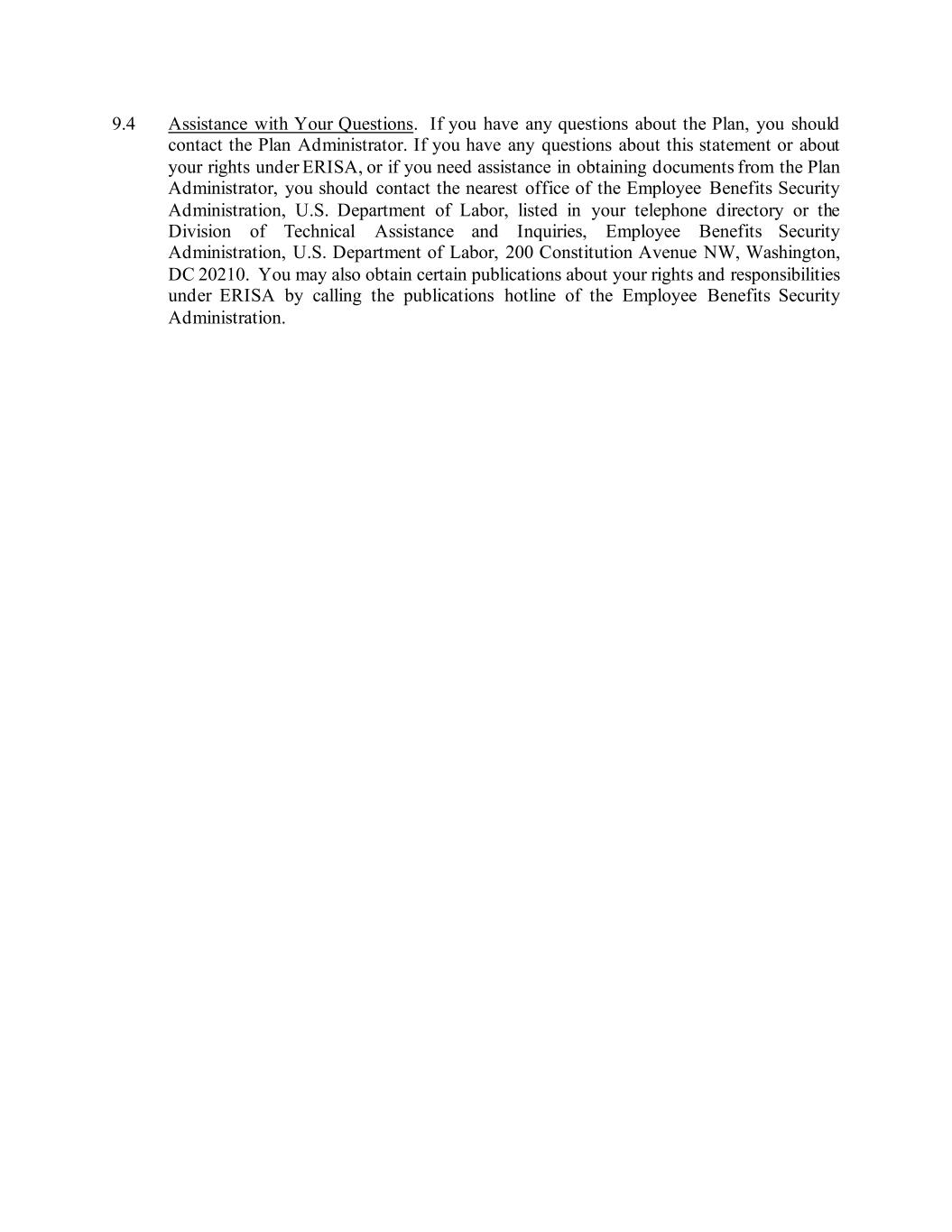
9.4 Assistance with Your Questions. If you have any questions about the Plan, you should contact the Plan Administrator. If you have any questions about this statement or about your rights under ERISA, or if you need assistance in obtaining documents from the Plan Administrator, you should contact the nearest office of the Employee Benefits Security Administration, U.S. Department of Labor, listed in your telephone directory or the Division of Technical Assistance and Inquiries, Employee Benefits Security Administration, U.S. Department of Labor, 200 Constitution Avenue NW, Washington, DC 20210. You may also obtain certain publications about your rights and responsibilities under ERISA by calling the publications hotline of the Employee Benefits Security Administration.
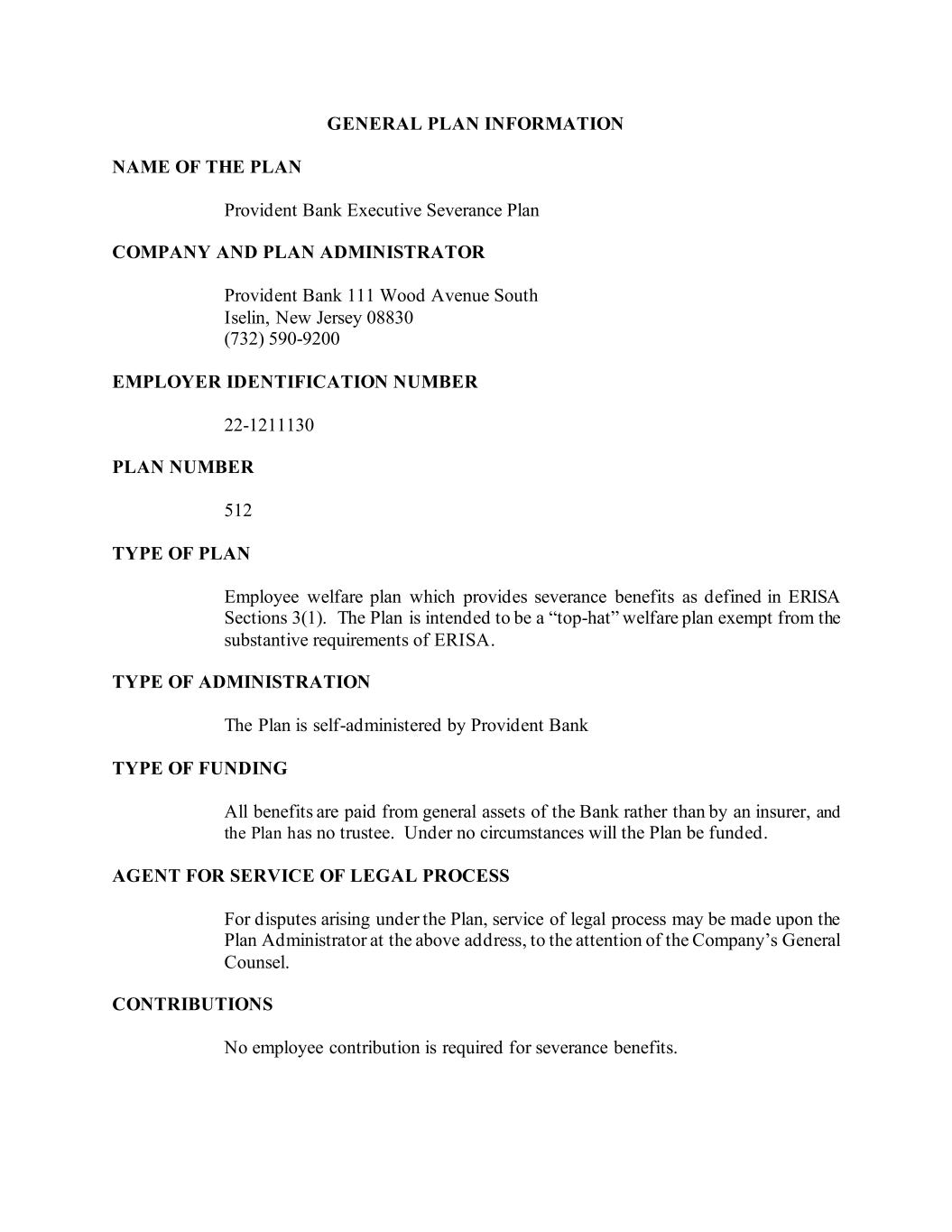
GENERAL PLAN INFORMATION NAME OF THE PLAN Provident Bank Executive Severance Plan COMPANY AND PLAN ADMINISTRATOR Provident Bank 111 Wood Avenue South Iselin, New Jersey 08830 (732) 590-9200 EMPLOYER IDENTIFICATION NUMBER 22-1211130 PLAN NUMBER 512 TYPE OF PLAN Employee welfare plan which provides severance benefits as defined in ERISA Sections 3(1). The Plan is intended to be a “top-hat” welfare plan exempt from the substantive requirements of ERISA. TYPE OF ADMINISTRATION The Plan is self-administered by Provident Bank TYPE OF FUNDING All benefits are paid from general assets of the Bank rather than by an insurer, and the Plan has no trustee. Under no circumstances will the Plan be funded. AGENT FOR SERVICE OF LEGAL PROCESS For disputes arising under the Plan, service of legal process may be made upon the Plan Administrator at the above address, to the attention of the Company’s General Counsel. CONTRIBUTIONS No employee contribution is required for severance benefits.